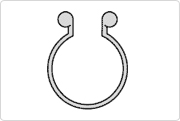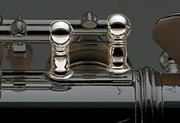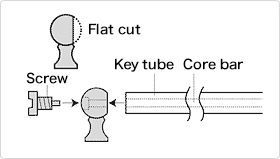How a Flute is Made
Constructing the body
The tone holes are formed to micron-level precision
Drawing the tone holes
A total of 16 tone holes (which can be large or small, and come in four different types) are drawn from the body of the flute. The rims are curled and the tone holes are formed to micron-level precision.

Cross-sectional view of the finished hole

Boring of oval holes

Drawing

Curling
Creating the key posts
The key posts that support the keys are manufactured and brazed to the post ribs, which are then soldered to the body of the flute.

Key posts

Cutting the key posts flat
A hole is cut in each key post and the tip of the key post is cut to a flat edge so that the key mechanism can be inserted.
* The core rod passes through the mechanical components of a woodwind instrument and is supported by key posts at both ends. This serves as an axle on which the key pipe turns.

Plating
Just like the head joint, the body is immersed in a plating solution and electroplated with silver.
